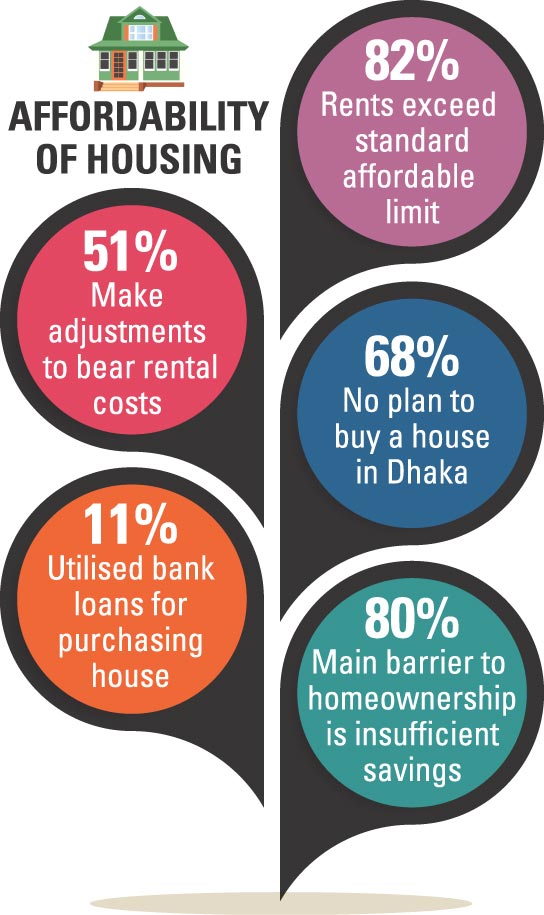The public sector supplies only 5.0 per cent of annual demand for 0.12 million housing units in Dhaka city while the private sector meets only about 20 per cent, leaving around 75 per cent shortage of dwellings, according to a new study.
Moreover, it says, the units supplied by the private sector are mostly beyond the reach of the lower-middle and middle-income groups of the city dwellers.
 Due to the short supply and high cost of housing facilities, the dwellers have to compromise their living standard by means of alternatives like shared-rentals and mess-housing, it adds.
Due to the short supply and high cost of housing facilities, the dwellers have to compromise their living standard by means of alternatives like shared-rentals and mess-housing, it adds.
Affording a house is getting more and more difficult day by day for the lower-middle and middle-income people in the city, says the study report titled 'State of Cities 2017: Housing in Dhaka'.
Brac Institute of Governance and Development (BIGD) launched its annual flagship report at a press conference at Brac Centre Inn on Sunday.
BIGD senior research associate Salina Aziz presented the study findings while its executive director Sultan Hafeez Rahman also spoke at the conference.
The survey was conducted between July and August period of 2017 among 400 households (HHs) in four overcrowded areas-old Dhaka, Mirpur, Badda and Rampura-largely dominated by lower and middle income people.
The study found that people spend over 30 per cent of their income on an average for house rent and utility services, which would be a threat for their sustainability in the city.
The private sector supplies 25,000 housing units annually while the public sector contribution was conspicuously absent from solving this crisis, the report says.
In context of rapid urbanisation, number of HHs has so far reached to 1.6 million in the city. City corporations have 2.5 times higher density of population compared to the other areas.
Over 68 per cent of the city-dwellers do not have own houses. It found over 57 per cent of the lower and middle income people having zero savings, keeping them out of the housing market.
Some 68 per cent of the tenants do not want to purchase flats in the city while only 6.0 per cent of the lower and middle income city dwellers are able to pay a down payment of Tk 1.9 million within six years, it also reveals.
Basic issues considered in the survey were adequacy, affordability, service quality, basic preparedness and tenants' security.
Expressing his fear over the city's gradually increasing economic polarisation, Mr Sultan Hafeez Rahman called for steps to save it from becoming a city of two classes - the rich and the poor - where the middle class will be squeezed.
Housing finance mechanism must be improved with easy instalment provision, lower interest rate and longer repayment period to come out of the trend that house should be bought with personal or family savings, he suggested.
He said spending over 30 per cent of HH income for housing and utility was unsustainable for the city dwellers. The rapid transit system should be developed with the secondary cities to reduce the inner-city pressure of Dhaka.
He said 95 per cent of the HHs has no fire safety systems although fire incidents have become an alarming trend recently. The risk will be augmented with the increase of the city congestion.
Besides, the post-disaster management would be difficult is case of a major earthquake in view of the present congestion, he added. Mr Hafiz called for conducting regular drill for the lower and middle income people on disaster management.
In her presentation, Salina Aziz said that in addition to topographical reasons, underutilisation of land was a major problem in Dhaka. The public land is kept unused for lengthy periods or reserved for future development. On an average, 20 per cent of the inner-city land remains unused.
There are 13,000 existing dwelling units in Dhaka for public employees and many more to be built. The housing supply depends entirely on private provision for the city dwellers.
Supply of housing caters the demand of upper-middle and high-income populations. Connectivity is a major shortcoming in less developed areas, discouraging the bigger real estate developers to invest in those areas.
The report revealed that an average size of owner-occupied residences is 1,261 sqft, average size of a rented unit is 950 sqft while the average floor space is around 1,050 sqft, very often compromising quality of the living.
More than 55 per cent of the HHs lives in houses smaller than 1,000 sqft. Only 5.0 per cent lives in houses of 2,000 sqft or more.
Limitation in affordability is a major reason why the buyers and renters are opting for smaller housing.
Over 61 per cent of the homeowners bought respective houses with personal or family savings, which should not be the criteria.
Only 11 per cent of the owners utilised commercial bank loans for purchasing houses.
High interest rates, short-term repayment periods and eligibility criteria are argued to be barriers for accessing the home loans, according to the study.
msshova@gmail.com